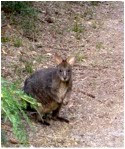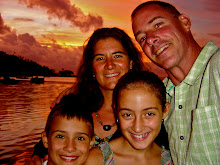On our recent trip around Tasmania, we were able to see a surprising number of critters, both dead on the road and alive near our campsites. Here are some facts about the animals we did see.
Short-beaked Echidna
Order - Monotremes
Scientific Name –Tachyglossus aculeatus
Range – Australia and Papua New Guinea
Measurements – 10 in (25 cm)long, 6 in (15 cm) wide
Weight – between 4.4 to 15.4 pounds (2-7 kg)
Description-Echidnas are small mammals that are covered with coarse hair and spines. They have snouts, which have the functions of both mouth and nose. Their snouts are elongated and slender. They have very short, strong limbs with large claws and are powerful diggers. Echidnas have a tiny mouth and a toothless jaw. They feed by tearing open soft logs, anthills and the like, and use their long, sticky tongue, which protrudes from their snout, to collect their prey.
Diet – The echidna's diet consists largely of ants and termites.
Reproduction – Female echidnas lay a single egg in their pouch. After ten days, the egg hatches and a puggle (baby echidna) is born. They are born blind and hairless, and consume milk from a gland within the pouch. After an average of four weeks, the puggle develops sharp spines, and must leave the pouch.
Predators - Dingos, dogs, eagles and humans.
Sightings – We saw the echidna pictured above foraging at Fortescue Bay, Tasman National Park, Tasmania AU.
Sources: Wikipedia, The Animal Files
Tasmanian Pandemelon
Order - Diprotodontia
Scientific Name – Thylogale billardierii
Range – Tasmania
Measurements – Males and females are most commonly 3.9 feet (1.2 m)
Weight – Males weigh 26.4 pounds (12 kg), females weigh 3.6 pounds (3.9 kg)
Description- The Tasmanian pandemelon is a short animal. It is dark brown with grey on the head.
Diet- Herbs and grasses
Reproduction – 70% of the babies are born in the beginning of winter.
Predators – Wild dogs and cats, foxes, cars and trucks.
Sightings – January 2010, numerous sightings around our campsite and on hikes near the beach at Narawantapu and Freycinet National Parks, Tasmania, AU. The animal pictured above was in Narawantapu NP.
Source: Wikipedia
Bennett’s Wallaby
Order Diprotodonta
Scientific name - Macropus rufogriseus
Range – widespread over Australia and Tasmania
Measurements - Head and body length - 31.5 in (80 cm); tail 29.5 in (75 cm)
Weight - Males 33 lbs (15 kg), Females weigh 24 lbs (11 kg)
Description—soft, thick fur; dark grey above and paler below except on the neck where it is reddish brown; dark nose and paws; mostly seen in the morning and evening, often in small groups
Diet – herbs and grasses
Reproduction – marsupial, babies are born from January to July
Predators – Humans, Tasmanian devil, wild dogs and cats, cars and trucks.
Sightings – January 2010, numerous sightings around our campsite at Friendly Beaches, Freycinet National Park, Tasmania, AU. I took the picture of the animal above at Friendly Beaches about 10 feet from our campervan.
Sources: Tasmanian Mammals: A Field Guide by Dave Watts (Tasmanian Conservation Trust, 1987), http://www.orford.tased.edu.au/bennetts.htm
Brushtail Possum
Order - Diprotodonta
Scientific Name – Trichosurus vulpecula
Range – Brushtails are widespread throughout Tasmania and are highly adaptable to a wide range of natural and human environments. Their natural and preferred habitat is forest, where they nest in tree hollows. They will also cohabit with humans in cities and towns where they seek shelter, warmth and protection in the dark recesses of buildings.
Measurements – similar in size to a domestic house cat.
Weight – An average female Brush tail possum weighs 2.6 and 7.7 pounds (1200-3500 grams). An average male brush tail possum weighs 2.8 and 10 pounds (1300-4500 grams).
Description- The Tasmanian brushtail possum has a pointed face, long oval ears, pink nose and bushy black tail. It has 3 main colour variations: silver grey, black and gold.
The brushtail possum is a nocturnal marsupial spending the daytime asleep in its nest and feeding at night. They are a tree living or arboreal animal and so are well adapted for climbing with their sharp claws; a hand-like back foot for grasping and a strong flexible (prehensile) tail for curling around branches. Brushtails also spend some time on the ground searching for food.
Diet – Brushtails are herbivores or plant-eaters. In the bush, they feed mainly on leaves of trees and shrubs, but they also enjoy succulent herbs, grasses, and garden plants. Meat or fat may occasionally be scavenged. They can damage crops and gardens because they are partial to exotic plants, pasture grasses and vegetables as well as native plants.
Reproduction – In Tasmania, the main breeding time is autumn. Most females breed annually after their first year. A single young is born 17–18 days after mating and spends 4–5 months in the pouch, attached to one of two teats. A further 1–2 months are spent suckling and riding on the mothers back until fully weaned. You will see this from September to November. Mortality is high once the young brushtail possums leave the pouch to establish their own home range.
Predators – The possum’s main predators are owls and Tasmanian Devils. Road vehicles are also a big threat.
Sightings – January 2010, several sightings at Discovery Campground outside Cradle Mountain National Park and Fortescue Bay, Tasman National Park, Tasmania, AU
Source: Tasmania National Parks website.
Common Wombat
Order - Diprotodontia
Scientific name - Vombatus ursinus
Range – Once found throughout southeast Australia, their range is now restricted to the coastal regions of southeast Australia, including: the southeast tip of Queensland, the eastern region of New South Wales, the eastern half and southern areas of Victoria, and the southeastern tip of South Australia. They are widespread in Tasmania, especially in the Northeast. They also occur on Flinders Island but no longer any other islands in Bass Strait.
Measurements - from about 90 to 115 cm (35 to 45 inches). The maximum reported range is from 67 to 130 cm (26 to 51 inches).
Weight - The average adult weighs from 48 to 86 pounds (22 to 39 kg), though some reports give a low of 33 pounds (15 kg) and a high of over 100 pounds (45 kg). Males tend to be slightly larger and heavier than females.
Description— Common wombats are considered solitary except during the breeding season, but there have been reports that they visit each other's burrows on occasion. Some reports say that Common wombats may also form colonies.
Diet – Wombats are completely herbivorous. They are grazers and their diet consists of grasses including snow tussocks for the Common wombat, and spear grass for the Southern Hairy-nosed wombat; herbs, roots including roots of grasses, bushes and trees, fungi including mushrooms and puffballs, shrubs, bark, especially the inner bark of certain trees, mosses, leaves, and marsh plants.
Wombats tend to prefer young tender grass shoots when available. Moss also seems to be a favorite food. Common wombats will also forage for food along the seashore. Additionally, wombats will sometimes eat farm vegetables.
Reproduction – Wombats reach sexual maturity at the age of two years. There is no specific mating season. Usually only one young is born and it will remain in the pouch for around six months. However, the job does not end there, as the juvenile will stay with the mother for almost another year.
Predators – Their main predators are dingos and Tasmanian devil’s.
Sightings – We sighted three wombats at Narawantapu and one at Cradle Mountain National Park. All sightings were near our campsites and took place in the early evening.
Sources: http://www.wombania.com/wombats/common-wombat.htm, http://en.wikipedia.org/wiki/Wombat
Unfortunately, we did not see platypuses or Tasmanian Devils during our stay in Tasmania. We hope to see some at the zoo in Melbourne or some other spot during our visit to Oz. The problem was that these animals are mostly active at night and we did not go hiking during those times. Some of the national park visitor centers and the Museum of Tasmania had information and stuffed specimens so we learned a lot about these animals.
The author and a new friend. Friendly Beaches. Freycinet NP. Tasmania, AU.







Wow! This was a great report Ian, you did a great job explaining about the animals you saw and that live on Tassie. Well done, I'd give you an A+ if I were your teacher.
ReplyDeleteTica, your report on the whole Tasmanian trip was fantastic! I especially liked your personal notes and opinions about where you were as it makes it easier to imagine you all there - not like reading a book or encyclopedia. You'd get an A+ too if I were your teacher, for such a thorough report.
Thank you both and your folks for taking such wonderful photos and telling such wonderful stories of your time in Tasmania. I love hearing about your adventures and look forward to learning more as you move onto Thailand.
All the best to you both.
Love,
Uncle Sam (and Aunt Trina)